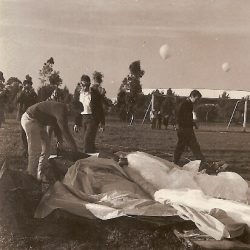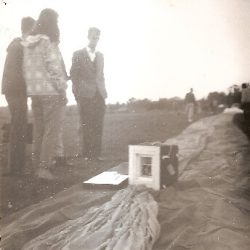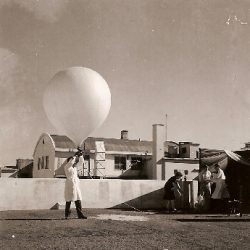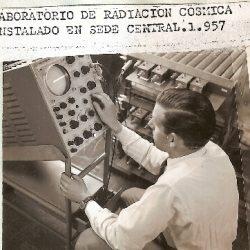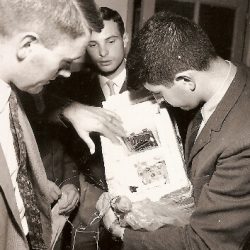
History
ITeDA was created on November 24th, 2009, with the aim of promoting research and development (R&D) projects and training human capital in the areas of universe sciences and the study of astroparticles, in response to the demands and opportunities generated by the establishment of the Pierre Auger Observatory in Argentina.
It is the first institute dependent on the National Atomic Energy Commission (CNEA), the National Scientific and Technical Research Council (CONICET) and the National University of San Martín (UNSAM).
Thanks to its contribution to the study and detection of astroparticles (elementary particles and atomic nuclei originating in outer space), ITeDA has positioned Argentina internationally in this field.
Currently, it also conducts research in observational cosmology, addressing topics such as cosmic background radiation, dark matter and dark energy. It also develops innovative technologies in electronics, telecommunications, data acquisition systems and atmospheric monitoring.
The institute has its facilities in Buenos Aires, Mendoza and Salta. It is under the purview of the Technology and Research in Universe Sciences Management, which reports to the Research, Development and Innovation Area Management of the CNEA.
Background
It can be said that the study of cosmic rays in Argentina began around 1950, in parallel with the creation of the CNEA. At that time, a shelter was built on the slopes of Cerro Laguna, near the Maipo Volcano in the Andes mountain range, in the province of Mendoza. The original plan was to develop an observatory with 30,000 Geiger detectors distributed over 2 km², but this project was never carried out. However, the shelter was later used to conduct advanced studies of cosmic radiation using nuclear plates.
The renowned Italian-Argentine physicist Juan G. Roederer participated in these investigations during the summer of 1950/51, while still a student at the Faculty of Exact and Natural Sciences of the University of Buenos Aires (FCEyN-UBA), along with other CNEA researchers such as Juana María Cardoso, Adulio Cichini, Beatriz Cougnet, Horacio Ghielmetti, Emma Pérez Ferreira, and Pedro Waloschek. This group later made valuable contributions from the Nuclear Plate Laboratory and later from the Cosmic Radiation Laboratory, both under the CNEA.
Likewise, during those years, various scientific expeditions were carried out to collect data from different points in the Andes and high mountain areas in the provinces of Mendoza, Neuquén and Catamarca, with the aim of studying the effects of cosmic radiation. The results of this research were published in 1954 in the journal Mundo Atómico by Juana María Cardoso of the CNEA.
In 1964, thanks to an agreement with the CNEA, the National Center for Cosmic Radiation was created, one of the first CONICET institutes, located at the FCEyN (National Institute of Astronomy and Space Physics) of the University of Buenos Aires (UBA). The center’s first director was Dr. Roederer. In 1969, this center was transformed into the current Institute of Astronomy and Space Physics (IAFE).
Project Auger: a window for the study of astroparticles
In 1995, a group of 140 physicists and engineers met at the Fermi National Accelerator Laboratory (Fermilab) in the United States, where they completed the design of the Pierre Auger Cosmic Ray Observatory, named after French physicist Pierre Victor Auger.
After securing support from the Partnership for Research in Universities, the U.S. National Science Foundation, UNESCO and the Grainger Foundation, a six-month workshop was held that same year. The outcome was a report explaining the scientific motivation for the project, potential locations and an estimate of the costs involved.
This report served as the basis for a proposal to request funding from the participating countries at that time, including Argentina, Armenia, Australia, Brazil, China, Egypt, France, Germany, Italy, Japan, Russia, South Africa, Sweden, the United Kingdom, the United States, and Vietnam. Argentina had already been nominated as a candidate country to host the project, not only because of its valuable background in the study of cosmic radiation but also due to the clear, wide skies and large surface area offered by the Pampa Amarilla, in the south of Mendoza province. Thus, Argentine astrophysicist Dr. Alberto Etchegoyen (who later became the first director of IteDA) and Dr. James Cronin (Nobel Prize winner in Physics in 1980) concluded that Argentina met the ideal conditions for an observatory of this nature to become a reality.
The multidisciplinary work of physicists, astrophysicists, astronomers and engineers from around the world finally resulted in the largest cosmic ray observatory ever built, located in Mendoza province, between the departments of Malargüe and San Rafael. This observatory consists of a main array of 1,660 surface detectors arranged in a hexagonal grid covering an area of 3,000 km², along with four buildings equipped with highly sensitive detectors that observe the faint fluorescence light generated by cosmic rays as they enter the atmosphere and interact with air molecules.
